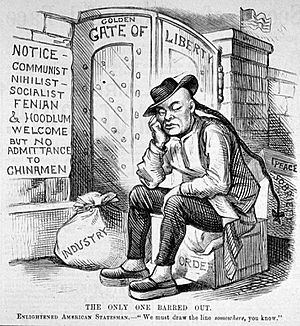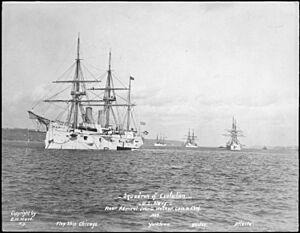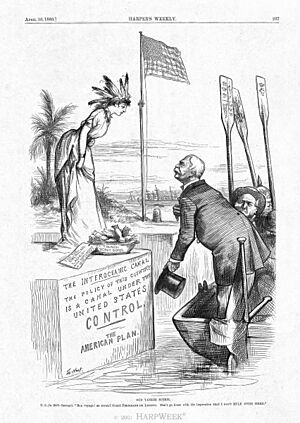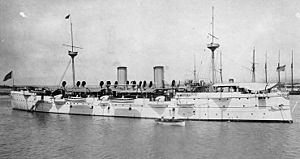History of U.S. foreign policy, 1861–1897 facts for kids
The history of U.S. foreign policy from 1861 to 1897 is about how the United States dealt with other countries. This period started with the American Civil War in 1861. It ended in 1897 when William McKinley became president. During these years, presidents like Abraham Lincoln, Ulysses S. Grant, and Grover Cleveland shaped America's place in the world.
During the Civil War, President Lincoln worked hard to stop European countries, especially Britain and France, from helping the Southern states (the Confederacy). Even so, France tried to take over Mexico. After the war, the U.S. government made France leave Mexico.
Later, the U.S. bought Alaska from Russia in 1867. This was a big step in expanding American territory. The U.S. also tried to annex the Dominican Republic, but this plan failed.
Towards the end of this period, the U.S. became more interested in trade with Latin America. It also got involved in disputes over places like Samoa and Hawaii. These events set the stage for America to become a bigger player on the world stage.
Contents
Leaders and Their Foreign Policy Goals
Lincoln's Time (1861–1865)
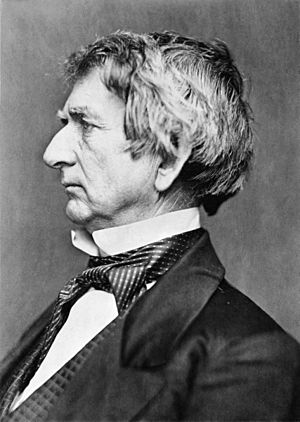
Abraham Lincoln became president in 1860. He chose William Seward as his Secretary of State. Seward's main job was to keep Britain and France from helping the Confederacy. The South hoped that Europe, especially Britain, would need their cotton so much they would join the war. This was called "King Cotton" diplomacy.
However, Britain needed American food more than Southern cotton. Also, Britain and France did not want to risk war with the United States. So, no major country officially recognized the Confederacy. This was a big win for Lincoln's diplomacy.
France, led by Emperor Napoleon III, tried to set up a puppet government in Mexico. They put Maximilian I of Mexico in charge. Seward warned that recognizing the Confederacy would mean war. Britain refused to join France in helping the South. This helped the Union win the Civil War.
Johnson's Time (1865–1869)
Andrew Johnson became president after Lincoln was assassinated. He kept William Seward as his Secretary of State. Seward continued to work on expanding U.S. influence. One major success was the purchase of Alaska.
Grant's Time (1869–1877)

Ulysses S. Grant became president in 1869. His main foreign policy leader was Secretary of State Hamilton Fish. Fish was known for being careful and fair.
Grant wanted to annex the Dominican Republic. He thought it would be a good place for freed slaves to live. He also saw it as a naval base. However, Senator Charles Sumner strongly opposed this plan. Sumner believed it would be too expensive and hurt the independence of other Caribbean nations. The Senate voted against the treaty.
Hayes's Time (1877–1881)
Rutherford B. Hayes became president after a very close election. He chose William M. Evarts as his Secretary of State. Hayes focused on protecting American interests, especially in the Western Hemisphere. He also dealt with border issues with Mexico.
Garfield and Arthur's Time (1881–1885)
James A. Garfield became president in 1881. He appointed James G. Blaine as Secretary of State. They wanted to increase trade with Latin America. Garfield was assassinated, and Chester A. Arthur became president. Blaine resigned, and Frederick T. Frelinghuysen took over. Arthur continued efforts to boost trade.
First Cleveland's Time (1885–1889)
Grover Cleveland became the first Democratic president since the 1850s. He was against expanding U.S. territory and getting involved in other countries' affairs. However, he strongly supported the Monroe Doctrine. This doctrine said that European powers should not interfere in the Americas.
Harrison's Time (1889–1893)
Benjamin Harrison defeated Cleveland in the 1888 election. James G. Blaine returned as Secretary of State. Harrison and Blaine pushed for more trade with other nations. They also tried to annex Hawaii, but this failed.
Second Cleveland's Time (1893–1897)
Cleveland won the presidency again in 1892. He continued his policy of not getting involved in other countries' affairs. He withdrew the treaty to annex Hawaii. When the Cuban War of Independence started in 1895, Cleveland said the U.S. would stay neutral.
Dealing with Other Countries
Civil War Diplomacy (1861–1865)
Both the Union and the Confederacy knew that foreign help could change the war. The Confederacy hoped for European support, like France helped the U.S. in the American Revolution. But all foreign countries stayed neutral. This was a big success for Secretary Seward.
European leaders saw the U.S. dividing as a chance to weaken a growing rival. Spain invaded the Dominican Republic, and France set up a puppet government in Mexico. However, many in Europe also wanted the war to end quickly because it hurt their economies.
At first, the Union struggled to get European public support. The Confederacy was better at talking about their fight for liberty and free trade, while ignoring slavery. But when Lincoln issued the Emancipation Proclamation in 1862, the war became about ending slavery. This made many Europeans support the Union. After Union victories at Gettysburg and Vicksburg, Europe believed the Confederacy would lose.
Britain and the Civil War
Rich people in Britain often favored the Confederacy. But the general public supported the United States. Trade continued between the U.S. and Britain. Britain got grain from the U.S. and sent manufactured goods.
A big problem happened in 1861. The U.S. Navy stopped a British ship, the Trent, and took two Confederate diplomats. This caused anger in Britain. Lincoln solved the problem by releasing the diplomats. This event was called the Trent Affair.
British shipyards built warships for the Confederacy, like the CSS Alabama. These ships caused a lot of damage to U.S. shipping. After the war, the U.S. demanded money from Britain for these damages. This was known as the Alabama Claims.
France and the Civil War
French Emperor Napoleon III wanted to rebuild a French empire in North America. In 1861, France invaded Mexico. They set up a puppet government with Maximilian I of Mexico as ruler. Napoleon III suggested that France, Britain, and Russia mediate the American Civil War. But other European powers refused. The U.S. did not recognize Maximilian's government. It threatened to force France out of Mexico.
Mexico After the War
After the Civil War, President Johnson sent General Philip Sheridan with 50,000 soldiers to the Texas-Mexico border. This showed France that the U.S. was serious about them leaving Mexico. Johnson also gave weapons to Mexican rebels. Napoleon III agreed to pull his troops out by 1867. Maximilian was captured and executed.
Later, in the 1870s, groups of bandits often crossed the Mexican border into Texas. President Hayes allowed the U.S. Army to chase these bandits into Mexico. The Mexican president, Porfirio Díaz, protested. But they later agreed to work together to stop the bandits.
Grant's Foreign Policy (1869–1877)
Grant focused mostly on issues inside the U.S. His Secretary of State, Hamilton Fish, was very skilled. Fish helped solve problems peacefully.
Santo Domingo (Dominican Republic)
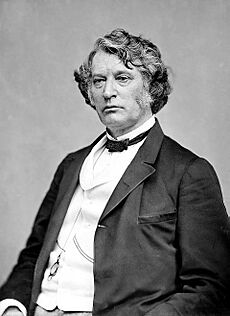
In 1869, Grant wanted to annex the Dominican Republic. He thought it would be good for the U.S. Navy and provide a safe place for freed slaves. He also hoped it would help end slavery in other Spanish colonies.
Grant sent people to negotiate a treaty. The Dominican president agreed. But Grant did not get enough support in Congress. Senator Charles Sumner strongly opposed the plan. He thought it would be too costly and hurt the independence of Haiti. The Senate voted against the treaty in 1870.
Grant tried again, even sending a special commission to the island. Frederick Douglass, a famous African American leader, was part of this commission. The commission supported annexation. But Congress still did not have enough interest to vote on it again.
Cuban Uprising
From 1868 to 1878, Cubans rebelled against Spanish rule. This was called the Ten Years' War. Many Americans felt sympathy for the Cuban rebels. Groups in New York raised money and smuggled weapons to Cuba.
Grant's government did not stop these actions. Many people wanted Grant to help the rebels with military aid. But Secretary Fish wanted peace. He kept Grant from officially recognizing Cuban independence. This was important because it could have hurt talks with Britain over the Alabama Claims.
Treaty of Washington (1871)
The Treaty of Washington was very important for solving international disputes. It used international arbitration, meaning outside experts helped settle disagreements. Secretary of State Hamilton Fish played a key role in this.
The main issue was the Alabama Claims. These were claims for damages caused by Confederate warships built in Britain, like the CSS Alabama. These ships hurt U.S. shipping a lot. The U.S. wanted Britain to pay for the damages.
In 1869, the U.S. Senate rejected an early treaty because it didn't pay enough. Senator Charles Sumner even suggested Britain give Canada to the U.S. as payment. This angered the British.
New talks started in 1871. Britain and the U.S. formed a commission. They agreed that an international group would decide the amount of damages. Britain expressed regret for the actions of the warships. Grant signed the treaty, and the Senate approved it.

The international group met in Geneva, Switzerland. In 1872, they awarded the United States $15.5 million in gold. This treaty also settled other border and fishing disputes. Historians say this treaty was a great example of peaceful problem-solving.
Korean Incident (1871)
In the 1800s, the U.S. Navy worked to open trade with Eastern countries like Japan and China. Korea was a closed country that did not allow foreign trade. The U.S. wanted a treaty after a U.S. ship's crew was killed there.

In 1871, Rear Admiral John Rodgers led a fleet of five U.S. ships to Korea. While exploring, Korean forts fired on the American ships. Rodgers demanded an apology, but the Koreans stayed silent. After ten days, Rodgers attacked and destroyed five Korean forts. Several hundred Korean soldiers and three Americans died. Korea still refused to talk. The American fleet left.
The U.S. defended Rodgers' actions. Later, in 1881, the U.S. finally negotiated the first treaty between Korea and a Western nation.
Alaska Purchase (1867)
Secretary of State Seward wanted to gain more land for the U.S. In 1867, Russia saw its colony in North America (Alaska) as a burden. They worried Britain might take it if a war broke out.
Russia offered to sell Alaska to the U.S. Seward negotiated the price up to $7.2 million. On March 30, 1867, the treaty was signed. The Senate approved the Alaska Purchase. Some people called it "Seward's Folly" (meaning a foolish act). But most Americans liked the idea of getting new land cheaply. They also liked keeping good relations with Russia and stopping British expansion.
Relations with Britain (Continued)
Fenian Raids
The Fenians were an Irish Catholic group. They wanted to force Britain to give Ireland independence. They recruited many Civil War veterans to invade Canada. Their goal was to pressure Britain.
Several small attacks were planned, but they mostly failed. The biggest raid was in 1866, when about 1,000 Fenians crossed into Canada. Canadian and British soldiers stopped them. The U.S. government at first allowed these actions. But by 1867, the U.S. Army stopped further raids. Britain realized that the U.S. was unhappy about Britain's actions during the Civil War. This helped push Britain to solve the Alabama Claims.
Aleutian Islands Dispute
President Harrison faced a problem with fishing rights off the coast of Alaska. Canada claimed fishing rights around the Aleutian Islands. The U.S. Navy seized some Canadian ships. In 1891, the U.S. and Britain began talks. They reached a compromise, and Britain paid compensation in 1898.
People Moving to and from Canada
After 1850, the U.S. grew faster in factories and cities. This attracted many immigrants from Canada. By 1870, one out of six Canadians had moved to the United States. Many went to New England for jobs in textile mills, which paid more. People often moved back and forth across the border.
After 1890, Canadian industry grew more. Also, the American frontier was closing. Thousands of American farmers moved north into Canada's Prairie Provinces looking for land.
Cuba and Spain
Ten Years' War (1868–1878)
The Cuban rebellion against Spain lasted ten years. Many Americans supported the Cuban rebels. Groups in New York raised money and sent weapons to Cuba. The Grant administration mostly ignored these actions.
People wanted Grant to help the rebels. But Secretary Fish wanted peace with Spain. He did not want to officially recognize Cuban independence. This was because it could have hurt talks with Britain over the Alabama Claims. Grant and Fish avoided military action. The Cuban revolt eventually ended.
Virginius Incident (1873)
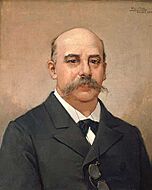
In 1873, a ship called the Virginius was caught carrying weapons and men to help the Cuban rebels. Spanish officials in Cuba quickly executed 53 people, including eight U.S. citizens. This almost caused a war between the U.S. and Spain.
Secretary of State Fish stayed calm. He found out that the Virginius might not have had the right to fly the American flag. The Spanish president apologized. Fish negotiated a deal. Spain returned the ship, paid money to the families of the executed Americans, and saluted the American flag. The crisis ended peacefully.
Cuban War of Independence (1895)
The Cuban War of Independence began in 1895. Cuban rebels wanted to break free from Spain. The U.S. and Cuba had strong trade ties. Many Americans wanted the U.S. to help the rebels.
President Cleveland did not support the rebels. He worried that an independent Cuba might fall under another European power's control. In June 1895, he announced that the U.S. would stay neutral. He warned Americans not to interfere.
Immigration from China
In 1868, the U.S. signed the Burlingame Treaty with China. This allowed Chinese immigrants to come to the U.S. freely. But after an economic downturn in 1873, some blamed Chinese immigrants for lower wages.
In 1879, Congress passed a bill to limit Chinese immigration. President Hayes vetoed it, saying it broke the treaty. This made many people in the West angry. Later, the Angell Treaty of 1880 allowed the U.S. to stop Chinese immigration.
When President Arthur took office, there were about 250,000 Chinese immigrants in the U.S. Most worked in California. Congress passed another Chinese Exclusion Act. It would have banned Chinese immigration for 20 years and denied them citizenship. Arthur vetoed it, saying 20 years was too long. Congress then passed a new bill with a 10-year ban. Arthur signed the Chinese Exclusion Act into law in 1882.
Later, Secretary of State Bayard extended the ban. President Cleveland pushed for the Scott Act. This law stopped Chinese immigrants who left the U.S. from returning. Cleveland signed it in 1888.
Peace and Agreements
South American Disputes
In 1878, President Hayes helped settle a land dispute between Argentina and Paraguay. Hayes gave the land to Paraguay. The Paraguayans honored him by naming a city and a department after him.
Secretary of State Blaine tried to help end the War of the Pacific. This war was between Bolivia, Chile, and Peru. Blaine wanted Peru to keep its land. But Chile, which had taken Peru's capital, refused. The war ended in 1883 without U.S. involvement.
Later, Britain and Venezuela argued over their border. President Cleveland and Secretary of State Richard Olney protested. They said Britain was violating the Monroe Doctrine. Britain first rejected this. But then British Prime Minister Lord Salisbury decided it was not worth angering the U.S. He agreed to arbitration. In 1899, a group decided most of the land belonged to British Guiana.
Trade Agreements
President Garfield and Secretary of State Blaine wanted to increase trade with Latin America. They hoped this would make the U.S. richer and prevent Britain from controlling the region. Blaine tried to organize a conference for American nations in 1882. This conference would discuss trade and settle disputes.
After Garfield's death, these plans slowed down. But Arthur and Frelinghuysen continued to promote trade. A trade treaty with Mexico was signed in 1882, but it failed to pass in Congress. Similar efforts with other countries also failed.
When Blaine returned as Secretary of State under President Harrison, he pushed for more trade agreements. The first Pan-American conference met in Washington in 1889. It did not make big diplomatic breakthroughs. But it did create an information center that became the Pan American Union.
Harrison's government then made eight trade agreements with Latin American countries. Harrison did not seek trade deals with Canada. He believed Canada was too tied to Britain. Harrison also sent Frederick Douglass as ambassador to Haiti. But he failed to get a naval base there.
Military Growth
After the Civil War, the U.S. Navy became much smaller and older. President Garfield's Secretary of the Navy, William H. Hunt, wanted to modernize it. His successor, William E. Chandler, created a board to plan improvements.
Based on their ideas, Congress paid for three new steel ships: the Atlanta, Boston, and Chicago. These were called the ABCD Ships. They also funded four monitors, which were uncompleted warships. President Arthur strongly supported these efforts. He believed a stronger navy would make the U.S. safer and more respected.
Under President Cleveland, Secretary of the Navy William C. Whitney continued to modernize the Navy. Sixteen more steel warships were ordered by 1888. These ships were very important later in the Spanish–American War of 1898. They included the battleships Maine and Texas.
The second Cleveland administration also worked on military modernization. They ordered the first ships designed for offensive action. The U.S. Army also adopted a new, modern rifle. In 1895–96, Secretary of the Navy Hilary A. Herbert ordered five new battleships and sixteen torpedo boats. This greatly increased the Navy's strength.
Samoa
Cleveland's first term saw the start of a problem over Samoa. The U.S., Germany, and Great Britain all had treaties with Samoa. They could trade and have naval bases there. Cleveland worried Germany wanted to take over Samoa. This was because Germany tried to remove the Samoan king.
By 1889, the U.S., Britain, and Germany were arguing over control of the Samoan Islands. German Chancellor Otto von Bismarck called a meeting in Berlin to solve it. The three countries agreed to the Treaty of Berlin. This treaty set up a three-power protectorate in Samoa. This meant the three countries would share control. This was the first time the U.S. had done something like this.
Hawaii
In 1874, President Grant hosted the King of Hawaii, Kalākaua. The King wanted to sell Hawaiian sugar to the U.S. without taxes. Grant and Secretary Fish made a successful free trade treaty in 1875. This brought Hawaii's sugar industry closer to the U.S. economy.
President Harrison wanted to annex Hawaii. It was a strategic location in the Pacific. American settlers controlled a growing sugar business there. In 1893, a coup overthrew Queen Liliʻuokalani. The new government, led by Sanford B. Dole, asked the U.S. to annex Hawaii.
Harrison was interested in expanding U.S. influence and having a naval base at Pearl Harbor. The U.S. consul in Hawaii recognized the new government. Harrison signed an annexation treaty in February 1893, just before leaving office. But the Senate did not act on it.
When Cleveland became president again, he withdrew the treaty. He believed the overthrow of the Queen was wrong. Cleveland sent someone to investigate. He tried to restore the Queen. But she refused to grant amnesty to those who overthrew her. Dole's government also refused to step down. Few Americans wanted to use force to put the Queen back in power.
Cleveland then left the issue to Congress. Republicans worried that an independent Hawaii would be taken over by another country, especially Japan. The Senate investigated and found that the overthrow was an internal matter. Cleveland then recognized the new Republic of Hawaii. In 1898, after Cleveland left office, the U.S. finally annexed Hawaii.
Other Events (1865–1897)
Panama Canal Plans
President Hayes was worried about plans to build a canal across the Isthmus of Panama. This land was owned by Colombia. Ferdinand de Lesseps, who built the Suez Canal, wanted to build it. Hayes feared this would be like France's actions in Mexico.
Hayes firmly stated his view on the Monroe Doctrine. He told Congress: "The policy of this country is a canal under American control... The United States cannot consent to the surrender of this control to any European power."
European Pork Ban
In the 1880s, Germany and other European countries banned U.S. pork. They claimed it caused a disease called trichinosis. This ban affected over $100 million in pork sales each year.
President Harrison got Congress to pass a law in 1890 to check the quality of exported meat. He also ordered his Agriculture Secretary to threaten Germany with a ban on their beet sugar. This worked. In 1891, Germany lifted its ban, and other countries followed.
Baltimore Crisis (1891)
In 1891, a problem arose in Chile. The U.S. minister in Chile gave safety to Chileans seeking refuge during a civil war. The crisis grew when sailors from the USS Baltimore went ashore in Valparaíso. A fight broke out, and two American sailors died. Many others were arrested.
The Baltimore's captain said Chilean police attacked the sailors without reason. President Harrison demanded payment for the damages. The Chilean foreign minister said Harrison's message was wrong.
Tensions grew very high, almost leading to war. Harrison threatened to end diplomatic relations. He said the U.S. must protect its citizens abroad. Secretary Blaine, after some confusion, also demanded an apology from Chile. Chile eventually apologized, and war was avoided.
Images for kids
-
African American Commissioner Frederick Douglass appointed by Grant believed Santo Domingo annexation would benefit the United States.



